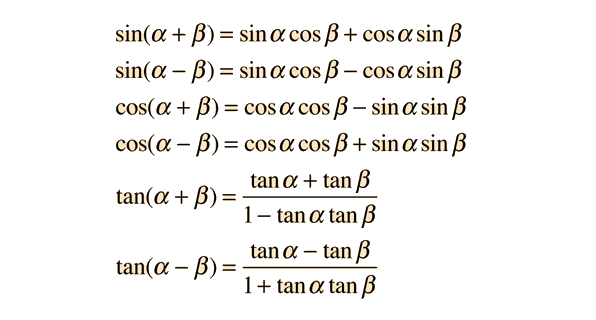Sum and difference identities are most commonly used when you have to find an obscure angle that isn't obvious on the unit circle.
Sum and Difference identities for sine, cosine, and tangent functions:

Proof of sin(x + y) = (sinx cosy) + (cosx siny)

Sin(x+y) = DE/AD
Sin(x+y) = (DF+FE)/AD
Sin(x+y) = (DF+BC)/AD
Now solve for the x's and y.
▲BDF: cosx = DF/DB
DF = DB(cosx)
▲ABC: sinx = BC/AB
BC = AB(sinx)
▲ABD: cosy = AB/AD
AB = AD(cosx)
Now substitute
(DF+BC)/AD = (DBcosx+ABsinx)/AD
(DF+BC)/AD = ((ADsiny)
The AD's all cancel out to leave you with
(sinx cosy) + (cosx siny)
Find the exact value of sin( /12)
/12)
Because  /12 is kind of an obscure angle on the unit circle, you can use an identity to solve it instead of the unit circle.
/12 is kind of an obscure angle on the unit circle, you can use an identity to solve it instead of the unit circle.
1. Find two angles on the unit circle that you ARE familiar with and either add or subtract them to get  /12. We will use (
/12. We will use ( /3 -
/3 -  /4).
/4).
2. Now we know that sin( /12) = sin(
/12) = sin( /3 -
/3 -  /4).
/4).
3. Because this equation involves the subtraction of sine functions, we will use the difference identity for sine which is sin(x - y) = (sinxcosy) - (cosxsiny).
4. Since we know that x =  /3 and y =
/3 and y =  /4, plug them into the the equation to get (sin(
/4, plug them into the the equation to get (sin( /3)cos(
/3)cos( /4)) - (cos(
/4)) - (cos( /3)sin(
/3)sin( /4)).
/4)).
5. Simplify to get ( /2)(
/2)( /2) - (1/2)(
/2) - (1/2)( /2).
/2).
6. Simplify again to get ( /4) - (
/4) - ( /4).
/4).
7. The final answer is }{4})
No comments:
Post a Comment